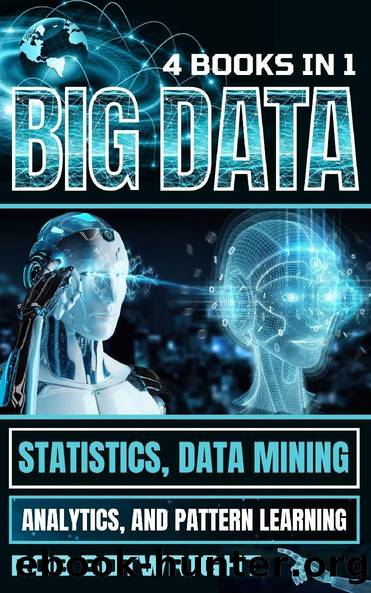Big Data: Statistics, Data Mining, Analytics, And Pattern Learning by Rob Botwright

Author:Rob Botwright
Format: epub
Chapter 2: Fundamentals of Machine Learning
Machine learning, a subfield of artificial intelligence, has gained immense popularity in recent years for its ability to enable computers to learn from data and make predictions or decisions without being explicitly programmed. In this section, we will delve into the fundamental concepts of machine learning, providing insights into its core principles, techniques, and applications.
Supervised Learning: Supervised learning is one of the fundamental paradigms in machine learning, where the algorithm learns from labeled data, consisting of input-output pairs, to make predictions or infer relationships between variables. In supervised learning, the algorithm aims to learn a mapping function that maps input features to corresponding output labels, allowing it to generalize to unseen data and make accurate predictions.
CLI command to train a supervised learning model using Python with the scikit-learn library:
pythonCopy code
from sklearn.linear_model import LinearRegression from sklearn.model_selection import train_test_split from sklearn.metrics import mean_squared_error # Split data into training and testing sets X_train, X_test, y_train, y_test = train_test_split(features, target, test_size=0.2, random_state=42) # Initialize and train a linear regression model model = LinearRegression() model.fit(X_train, y_train) # Make predictions on the testing set predictions = model.predict(X_test) # Evaluate model performance using mean squared error mse = mean_squared_error(y_test, predictions) print("Mean Squared Error:", mse)
This command will split the data into training and testing sets, initialize and train a linear regression model on the training data, make predictions on the testing set, and evaluate the model performance using mean squared error.
Unsupervised Learning: Unsupervised learning is another fundamental paradigm in machine learning, where the algorithm learns patterns and structures from unlabeled data without explicit supervision. In unsupervised learning, the algorithm aims to discover hidden patterns, relationships, or groupings within the data, enabling tasks such as clustering, dimensionality reduction, and anomaly detection.
CLI command to perform clustering using Python with the scikit-learn library:
pythonCopy code
from sklearn.cluster import KMeans from sklearn.preprocessing import StandardScaler import matplotlib.pyplot as plt # Standardize the feature matrix scaler = StandardScaler() scaled_features = scaler.fit_transform(features) # Initialize and fit a K-means clustering model kmeans = KMeans(n_clusters=3) kmeans.fit(scaled_features) # Visualize the clustering results plt.scatter(features[:, 0], features[:, 1], c=kmeans.labels_, cmap='viridis') plt.scatter(kmeans.cluster_centers_[:, 0], kmeans.cluster_centers_[:, 1], marker='x', color='red') plt.xlabel('Feature 1') plt.ylabel('Feature 2') plt.title('K-means Clustering') plt.show()
This command will standardize the feature matrix, initialize and fit a K-means clustering model to the standardized features, and visualize the clustering results.
Feature Engineering: Feature engineering is a critical aspect of machine learning, involving the selection, transformation, and creation of input features to improve model performance and generalization. Effective feature engineering techniques can enhance model interpretability, reduce overfitting, and capture meaningful relationships between variables.
CLI command to perform feature scaling using Python with the scikit-learn library:
pythonCopy code
from sklearn.preprocessing import MinMaxScaler # Initialize Min-Max scaler scaler = MinMaxScaler() # Perform feature scaling on the feature matrix scaled_features = scaler.fit_transform(features)
This command will initialize a Min-Max scaler and perform feature scaling on the feature matrix, ensuring that all features are scaled to the same range.
Model Evaluation and Validation: Model evaluation and validation are essential steps in machine learning, allowing practitioners to assess the performance of trained models and ensure their reliability and generalization capability.
Download
This site does not store any files on its server. We only index and link to content provided by other sites. Please contact the content providers to delete copyright contents if any and email us, we'll remove relevant links or contents immediately.
Deep Learning with Python by François Chollet(14616)
The Mikado Method by Ola Ellnestam Daniel Brolund(11877)
Hello! Python by Anthony Briggs(11791)
OCA Java SE 8 Programmer I Certification Guide by Mala Gupta(11240)
Dependency Injection in .NET by Mark Seemann(11001)
A Developer's Guide to Building Resilient Cloud Applications with Azure by Hamida Rebai Trabelsi(10511)
Algorithms of the Intelligent Web by Haralambos Marmanis;Dmitry Babenko(9832)
The Well-Grounded Java Developer by Benjamin J. Evans Martijn Verburg(9420)
Grails in Action by Glen Smith Peter Ledbrook(9163)
Hit Refresh by Satya Nadella(9038)
Sass and Compass in Action by Wynn Netherland Nathan Weizenbaum Chris Eppstein Brandon Mathis(8808)
Secrets of the JavaScript Ninja by John Resig Bear Bibeault(8594)
The Kubernetes Operator Framework Book by Michael Dame(8461)
Test-Driven iOS Development with Swift 4 by Dominik Hauser(8308)
Exploring Deepfakes by Bryan Lyon and Matt Tora(8285)
Robo-Advisor with Python by Aki Ranin(8239)
Practical Computer Architecture with Python and ARM by Alan Clements(8211)
Implementing Enterprise Observability for Success by Manisha Agrawal and Karun Krishnannair(8182)
Building Low Latency Applications with C++ by Sourav Ghosh(8084)
